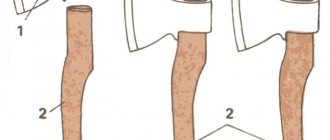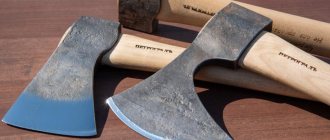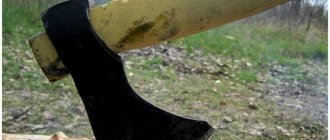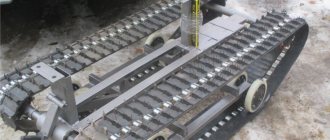Forged axes are reliable and useful tools in everyday life . This article is devoted to the independent production of axes. It can be forged using one of the well-known technologies: forge welding, solid forging, connecting the blade to the body with rivets, sometimes the eye was made by drilling in a solid metal blank. Due to its versatility, the chopping tool remains the most popular tool. And if you change the size and shape of the blade (strike), the length of the handle, you can create various versions of an ax for multifunctional or specialized purposes. Detailed information is presented in the article.
Forged carpenter's axe. Toporsib Photos
There are several types of forged axes:
- taiga;
- carpentry;
- meat;
- carpentry;
- hunting;
- tourist, hiking;
- gift
Types of axes
Let's look at the variations of axes:
- A cleaver is a heavy cone-shaped axe. Due to its heavy weight, it is well suited for cutting large, hard wood.
- Carpenter's - light in weight and size, has a pointed blade. Used for careful, precise, careful work with wood.
- Taiga - suitable for cutting down trees, harvesting trees, building a hut, removing bark and branches.
- Tsalda – designed for clearing the area of bushes.
- Kitchen (cook's) - intended only for chopping bones. It is a small hatchet with a short handle and a large “blade”.
- Lumberjack - used only for cutting down trees. Consists of a long ax and a wide, sharp blade.
Of all the above types, the taiga ax is the most necessary and useful.
Distinctive features of the taiga ax:
- Light weight.
- Small piercing surface area (makes it possible to drive it as deep as possible into the wood).
- Specific sharpening of the blade (the back edge is much smaller, thinner than the front.
This feature is made in order to use this type of ax as a cleaver (if the blow is delivered correctly. A regular ax has a blade of the same shape for precise work with wood).
Application of spring steel
The versatility of the characteristics of 65G steel allows you to make knives for various purposes from springs. Cheap homemade products cope with daily work in the kitchen no worse than expensive branded models. For the same reason, tourists, hunters and fishermen prefer spring steel for knives made independently or by craftsmen. They are also popular with the military. During their service, soldiers often make army knives for their needs, because they can be made from springs with affordable tools.
Long strips from heavy trucks are forged into swords for role-playing games. A machete is used to cut off branches and fight overgrown bushes. Thick springs make convenient hatchets for chopping poultry carcasses and large pieces of meat.
Sharpening the piercing part of the taiga ax
Excellent performance of the hatchet is ensured by a properly sharpened blade. The sharpening angle depends on the activity you will perform with the axe.
The taiga ax is sharpened at an angle of 30-35 ̊. If they will be working with fresh wood, then we sharpen it at an angle of 25 ̊.
If you use a sharpening wheel for sharpening, then the ax handle must be held at an angle of 40-45 ̊. We reproduce the sharpening slowly and carefully.
If you have all the necessary tools in stock, a photo of the step-by-step production of an ax, then its creation will not take a lot of time, effort and money, and in return you will receive a high-quality ax made by yourself.
But do not forget that with a piercing part made of high-quality metal, the ax will last much longer and if the handle is treated with linseed oil, it will not rot and deteriorate.
Characteristics of the taiga ax and what it should be like
Since the parameters of the ax and blade are very different from the usual sizes of “household” axes and will seem unusual to many, you first need to decide what problems can be solved with this miracle device:
- Tree cutting. Felling in a sawmill, sanitary felling or preparing firewood for a log house - this is exactly what this ax was made for.
- Rough work with logs (that's right, rough!). Suitable for removing branches, making grooves, removing thick bark and similar work.
- Ax for survival. A lightweight hunting tool, suitable for quickly creating bags and animal traps.
- Construction of huts, decking, wooden “instant” houses. A hut will not be built without an axe, but with its help you can do it 4 times faster than when working with a carpenter's ax blade.
- Working with firewood. If accuracy is a secondary concern, then this tool is perfect for the job.
If you want to make a tool for precision work, then it would be better to consider forged axes with a straight, long blade. They are of little use when cutting down trees, but the accuracy is very high. In addition to the quality of the “cut,” there are many differences between a taiga ax and a regular one.
Shorter rounded blade
. The ax is much lighter than a regular ax, and the small working surface area allows it to be buried much deeper into the wood; it is suitable for cutting wood across the grain. The tool is much easier to carry (the ax and head together weigh no more than 1400 grams).
Presence of a long beard
. Its main task is to protect the wooden part from breaking under strong impacts. Up to 60% of the impact force is absorbed. But it does not protect against impacts against logs - this is a misconception, since the special shape of the blade already performs this function.
Special ax sharpening
. The rear edge of the blade is almost 2 times thinner than the front. This is done for the purpose of using the ax as a cleaver (if struck correctly). In a conventional tool, the edge has the same thickness for high precision work.
Special angle of inclination of the ax
. The head of the taiga ax forms a much smaller angle with the ax handle. This allows you to increase work efficiency, relieve hand fatigue and increase productivity when cutting trees. The impact becomes much stronger than that of a carpenter's axe, where the head and blade are placed at an angle of 90 degrees. They try to make all handmade taiga axes with an angle of 75-65 degrees - this is their main difference.
They use ordinary sharpening wheels, since they can be very diverse. The main thing is to observe the difference in the thickness of the leading and trailing edges, since it is this that affects the productivity of the forester.
Technological nuances of hardening
Hardening, which is a type of heat treatment of metals, is performed in two stages. First, the metal is heated to a high temperature and then cooled. Different metals and even steels belonging to different categories differ from each other in their structure, therefore their heat treatment modes do not coincide.
Heat treatment modes for some non-ferrous alloys
Heat treatment of metal (hardening, tempering, etc.) may be required for:
- its strengthening and increasing hardness;
- improving its ductility, which is necessary when processing by plastic deformation.
Many specialized companies harden steel, but the cost of these services is quite high and depends on the weight of the part that needs to be heat treated. That is why it is advisable to do this yourself, especially since you can do it even at home.
If you decide to harden the metal on your own, it is very important to correctly carry out such a procedure as heating. This process should not be accompanied by the appearance of black or blue spots on the surface of the product. The bright red color of the metal indicates that heating is occurring correctly. This video demonstrates this process well, which will help you get an idea of the degree to which to heat the metal subjected to heat treatment.
As a heat source for heating the metal product that needs to be hardened to the required temperature, you can use:
- a special oven powered by electricity;
- blowtorch;
- an open fire that you can make in the yard of your house or in your country house.
Hardening a knife on open coals
The choice of heat source depends on the temperature to which the metal to be heat treated must be heated.
The choice of cooling method depends not only on the material, but also on the results to be achieved. If, for example, it is not necessary to harden the entire product, but only a separate section of it, then cooling is also carried out pointwise, for which a stream of cold water can be used.
The technological scheme by which metal is hardened may include instant, gradual or multi-stage cooling.
Rapid cooling, which uses one type of coolant, is optimal for hardening steels classified as carbon or alloy. To perform such cooling, you need one container, which can be a bucket, barrel, or even an ordinary bathtub (it all depends on the size of the item being processed).
Do-it-yourself taiga ax - making the tool head
It won’t be possible to forge or cast a metal part at home, so let’s take the simplest route and in a few steps make a taiga ax out of an ordinary carpenter’s axe.
STEP 1
: we take an old metal head from an ax, the weight of which is approximately 1400-1600 grams (the best option) and cut off the front protrusion of the blade flush with the butt.
A protrusion of 5-8 degrees is allowed
, but it is better to remove it if you need the right ax.
STEP 2
: we make the back of the blade round, we cut off the metal so that the entire touching surface is without corners. This can be done using a regular grinder or a medium-grit sanding wheel.
STEP 3:
cut out a semicircle in the inner part of the blade. It is necessary for a comfortable grip of the ax when it is necessary to trim something or for more precise work. With this form of an ax you can pull up small logs or hang the ax on a tree branch. In addition, you can reduce the weight of the head by 150-200 grams.
STEP 4
: cut off the upper corners of the butt. This will reduce weight and increase the maneuverability of the tool. This operation can be omitted if you are satisfied with the axe.
Now all that remains is to choose how to sharpen the ax. It is very important to use a low-speed tool (a grinder cannot be used!). A sanding machine with a large wheel and medium grit is ideal. The sharpening must be double-sided and have a moderately sharp edge (a very sharp one will die on the first tree).
DIY making
You can make any type of ax on your own. It can be simple, hunting, Scandinavian, hiking, intended for throwing (throwing) or simply decorative - there are a great many options. It is also possible to update the tool and build a completely new and convenient tool from an old axe. In order to carry out such work yourself at home, you will first need to make an accurate drawing with all the indicators of the planned tool. It is important to indicate the dimensions of all parts, as they can vary greatly. For example, the handle of an ax is not only quite large, but also medium or small, as is the blade.
Read also: What is the difference between an orbital sander and an eccentric sander?
From a spring
A small hatchet can be made from an old spring. This can be not only a working tool, but also an original decorative tool, similar to a Viking axe. You need to do this thing as follows.
- You need to take an old spring from a car with a width of 10 cm and a length of about 40 cm. Using a previously prepared template, draw the contours of the planned device on the springs using a marker.
- Draw the contours of the ax using a grinder with cutting wheels. Then carefully sand the cut piece, giving it the desired shape.
- For particularly complex metal work, it is permissible to use a drill.
- You can use an old chair leg as a handle. Drill 3 holes in the spring for fastening to the handle.
- Cut a piece of the desired length from the leg. Saw this part into two halves. Drill 3 holes in each of them. After this, you need to assemble the handle, fixing it with bolts and screws. Draw the shape of the part on a grinding machine.
- Finally, sharpen the blade. The result will be a beautiful mini hatchet. It is suitable for outdoor recreation or in a summer cottage.
An ax from a spring can be made independently by a master blacksmith. The handle is made of wood or reinforcement parts. Such axes are not expensive in their own way. Tools made from springs are not bulky; the ax can be made of any modification: a cleaver ax, a tourist hatchet, a mini hatchet for harvesting work. In addition, the master can use his imagination when making an ax. We offer 7 photos of homemade axes.
Do-it-yourself splitting ax made from springs. This ax is convenient for chopping wood.
Welded homemade ax from a spring. The weapon is skillfully welded from separate parts.
An ax is a cleaver made from part of a spring. The most common ax model. And for ease of use, the handle is made of wood.
A mini hatchet made from springs is an excellent option for cutting down forest thicket. Lightweight and compact, it is convenient to take it with you on a walk or quiet hunt.
Spring ax. A lightweight version with a thin handle and a sharp blade.
Homemade hatchet made from springs. It is convenient to take such a hatchet on a hike as an indispensable assistant.
A homemade ax is made from a spring, and the handle is welded from a piece of reinforcement. This ax model can be conveniently stored by hanging it on a hook in the utility room. There is no need to worry that the handle will dry out or the blade will fly out during operation.











